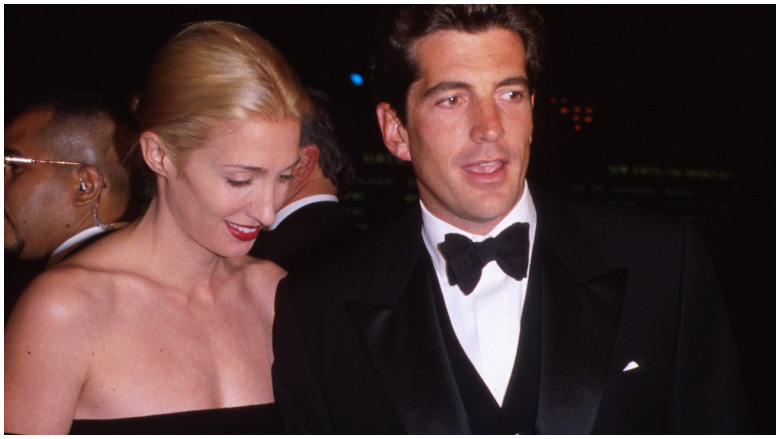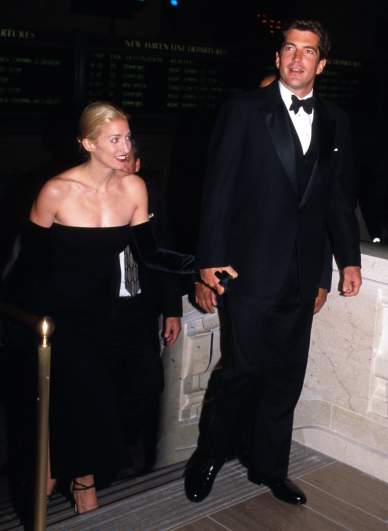
What was the cause of JFK Jr.'s plane crash?
The plane crash that killed JFK Jr., his wife, Carolyn Bessette, and her sister, Lauren Bessette, is an American tragedy. The fallen president’s son, so enshrined in the collective memory of a nation, with his tiny salute before a flag-draped casket, was gone, simply, tragically, way too soon.
Even nearly 10 years later, it’s almost impossible to absorb the sadness and the senselessness of it all. Thank goodness his mother didn’t live to endure it. That’s about all you can say. (You can see more photos of the couple and plane crash scene area here.)
On January 3, 2019, ABC is revisiting the tragedy of that terrible day in July 1999 in a documentary called The Last Days of JFK Jr. It contains “interviews and previously unseen video about Kennedy and his wife, Carolyn Bessette-Kennedy,” according to EW.
However, what was the plane crash’s cause? What precipitated the deadly chain of events that led the young Kennedy’s plane to plummet fatally into the sea, killing all three on board?
“Biography: JFK Jr—The Final Year” will run on Tuesday, July 16, 2019 at 9 p.m. ET on A&E Network. “July 16, 2019 marks the 20-year anniversary of John F. Kennedy Jr.’s death. This two-hour documentary special, airing on the anniversary, reframes the last year of his life in an entirely new way,” A&E wrote in a statement.
Here’s what you need to know:
The Safety Board Blamed ‘Pilot Failure to Maintain Control’ for JFK Jr.’s Plane Crash
Ntsb Report by on Scribd
The National Transportation Safety Board extensively investigated the cause of JFK Jr.’s plane crash. You can read the press release announcing its findings here and the NTSB reports above and later in this article.
The board investigated the “crash of a Piper Saratoga II aircraft last summer that killed the pilot, John F. Kennedy, Jr.; his wife, Carolyn Bessette Kennedy; and her sister, Lauren Bessette. The airplane crashed about 9:41 p.m., on July 16, 1999, near Martha’s Vineyard, Massachusetts,” the press release states.
The probable cause of the accident, as stated in the accident report, is:
“The pilot’s failure to maintain control of the airplane during a descent over water at night, which was a result of spatial disorientation. Factors in the accident were haze and the dark night.”

John F. Kennedy, Jr. and wife Carolyn attend a function in honor of his mother, Jacqueline Onasis, October 4, 1998 at Grand Central Station in New York City.
The New York Times, in 2000, summarized the report by saying the NTSB had blamed “pilot error,” determining the case was “probably that Mr. Kennedy, with hardly any experience flying his plane alone at night, became disoriented in haze” and that he “wanted to do it alone” rather than fly with an instructor. He only had roughly an hour of flying time at night solo, the newspaper reported.
The NTSB accident number is NYC99MA178. You can read the full report here:
This is the site where you an search for the report yourself using the above accident number.
The report lists these findings:
“Occurrence #1: LOSS OF CONTROL – IN FLIGHT
Phase of Operation: DESCENT
Findings
1. (F) LIGHT CONDITION – DARK NIGHT
2. (F) WEATHER CONDITION – HAZE
3. (C) AIRCRAFT CONTROL – NOT MAINTAINED – PILOT IN COMMAND
4. (C) SPATIAL DISORIENTATION – PILOT IN COMMAND
———-
Occurrence #2: IN FLIGHT COLLISION WITH TERRAIN/WATER
Phase of Operation: DESCENT – UNCONTROLLED
Findings
5. TERRAIN CONDITION – WATER.”
It says:
“The noninstrument-rated pilot obtained weather forecasts for a cross-country flight, which indicated visual flight rules (VFR) conditions with clear skies and visibilities that varied between 4 to 10 miles along his intended route. The pilot then departed on a dark night. According to a performance study of radar data, the airplane proceeded over land at 5,500 feet.”
The report continues:
“About 34 miles west of Martha’s Vineyard Airport, while crossing a 30-mile stretch of water to its destination, the airplane began a descent that varied between 400 to 800 feet per minute (fpm). About 7 miles from the approaching shore, the airplane began a right turn. The airplane stopped its descent at 2,200 feet, then climbed back to 2,600 feet and entered a left turn. While in the left turn, the airplane began another descent that reached about 900 fpm. While still in the descent, the airplane entered a right turn. During this turn, the airplane’s rate of descent and airspeed increased. The airplane’s rate of descent eventually exceeded 4,700 fpm, and the airplane struck the water in a nose-down attitude.”
Meanwhile, says the report, “Airports along the coast reported visibilities between 5 and 8 miles. Other pilots flying similar routes on the night of the accident reported no visual horizon while flying over the water because of haze. The pilot’s estimated total flight experience was about 310 hours, of which 55 hours were at night. The pilot’s estimated flight time in the accident airplane was about 36 hours, of which about 9.4 hours were at night.”
The report continues:
About 3 hours of that time was without a certified flight instructor (CFI) on board, and about 0.8 hour of that was flown at night and included a night landing. In the 15 months before the accident, the pilot had flown either to or from the destination area about 35 times. The pilot flew at least 17 of these flight legs without a CFI on board, of which 5 were at night. Within 100 days before the accident, the pilot had completed about 50 percent of a formal instrument training course. A Federal Aviation Administration Advisory Circular (AC) 61-27C, ‘Instrument Flying: Coping with Illusions in Flight,’ states that illusions or false impressions occur when information provided by sensory organs is misinterpreted or inadequate and that many illusions in flight could be caused by complex motions and certain visual scenes encountered under adverse weather conditions and at night. The AC also states that some illusions might lead to spatial disorientation or the inability to determine accurately the attitude or motion of the aircraft in relation to the earth’s surface. The AC further states that spatial disorientation, as a result of continued VFR flight into adverse weather conditions, is regularly near the top of the cause/factor list in annual statistics on fatal aircraft accidents. According to AC 60-4A, ‘Pilot’s Spatial Disorientation,’ tests conducted with qualified instrument pilots indicated that it can take as long as 35 seconds to establish full control by instruments after a loss of visual reference of the earth’s surface. AC 60-4A further states that surface references and the natural horizon may become obscured even though visibility may be above VFR minimums and that an inability to perceive the natural horizon or surface references is common during flights over water, at night, in sparsely populated areas, and in low-visibility conditions. Examination of the airframe, systems, avionics, and engine did not reveal any evidence of a preimpact mechanical malfunction.
Ann Freeman, the mother of Carolyn and Lauren Bessette, filed a wrongful death action against the Kennedy estate that some news reports said was settled for $15 million. However, the family’s attorney in 2001 denied that settlement amount amidst reports that they had asked a judge to allow a settlement in the wrongful death case Ann Freeman brought against the Kennedy estate.